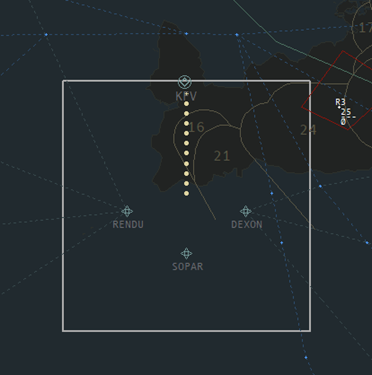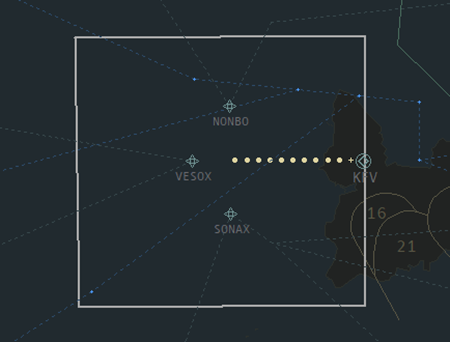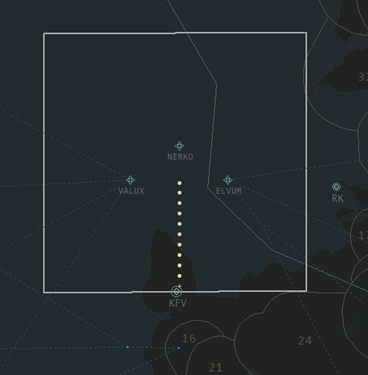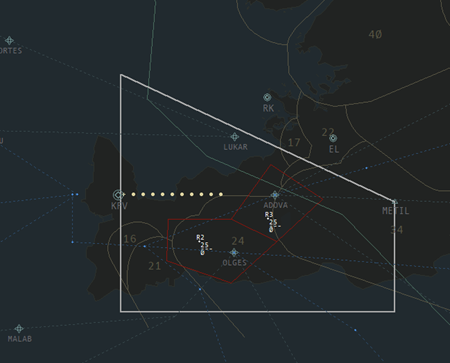Keflavik Approach
Keflavik Approach provides approach control service to all aircraft within the KF sector of the Faxi TMA (as well as bandboxing the RK sector if Reykjavik Approach is offline – see Chapter 5.)
Arrivals
Reykjavik Control clears aircraft onto the STAR & descends them to FL100. If Reykjavik Control is offline, then APP may contact aircraft early (3-5 mins before they reach the first waypoint of the STAR) to issue this STAR clearance and descent.
Traffic permitting, it is generally common practice during low-moderate traffic for APP to cancel the STAR and route aircraft directly to the last waypoint of the STAR, i.e., the ILS Z approach IAFs. When doing so, Approach must take care not to violate relevant MVA areas.
When the aircraft is approaching the last waypoint of the STAR, APP should descend them to 3000ft (when RWY 10/19 in use) or 3500ft (when RWY 01/28 in use) and clear them for the ILS Z approach. The ILS Z approach is the standard/preferred approach for all runways.
To ensure that no aircraft violates the minimum horizontal separation of 3 NM in the TMA, APP shall aim to establish aircraft onto the ILS with at least 5 NM separation.
During single runway operations, it is recommended to aim for at least 5-7 NM of separation between all arrivals, to ensure sufficient gaps/buffer time for departures.
The ILS Z approaches have a published minimum speed of 160kts until 4 NM from the airport. APP may issue a higher/lower speed requirement, or cancel this speed restriction, if necessary for traffic separation/sequencing.
Arrivals on the ILS Z or RNP approaches may be transferred to TWR as soon as they have crossed the IAF. All other arrivals should be transferred once established on the ILS/final approach.
Non-Standard Arrivals and Approaches
If aircraft are unable to accept the ILS Z approach, then alternative approaches should be offered in order of precision.
RNP & LOC Z Approaches
The published RNP & LOC Z approaches largely mirror the ILS Z approaches, and share the same published minimum speed of 160kts until 4 NM from the airport. Handling them is thus similar to an ILS Z approach, simply substituting “RNP” or “LOC Z” for “ILS Z” in the approach clearance.
Vectored ILS Approaches
Aircraft on a vectored ILS approach into BIKF should be established no closer than 10 NM from the airport at no greater than 30° from runway heading.
ILS Y / VOR Approaches
The ILS Y and VOR approaches at BIKF are non-RNAV ILS procedures. They are teardrop-shaped procedures commencing from KFV VOR. Aircraft flying these approaches may be routed direct to KFV as soon as practical. Upon approaching KFV, Approach should clear the aircraft for the ILS Y approach. The aircraft should then report beacon outbound, and then established on the ILS/final approach course as appropriate.
Due to the difficulty of sequencing aircraft on these procedures while the ILS Z/RNP approaches are also in use, it is highly recommended only to approve ILS Y/VOR approaches when traffic permits. During high traffic loads, non-RNAV aircraft seeking to perform an ILS approach should be offered a vectored ILS approach.
Since aircraft on the ILS Y and VOR approaches will need to descend below 3000ft (i.e., into the BIKF CTR) as a part of the approach, Keflavik Approach should coordinate with Keflavik Tower to make them aware of any aircraft on such approaches.
NDB Approach (RWY 10)
The NDB approach for RWY 10 is a racetrack procedure. The IAF is the KF (Keflavik) NDB – aircraft may be routed direct KF as soon as practical. The aircraft should be asked to report on final approach course, at which point it may be transferred to Tower.
Like the ILS Y and VOR approaches, since the NDB approach requires the aircraft to descend below 3000ft into the BIKF CTR, Keflavik Approach should coordinate with Keflavik Tower to notify them of any aircraft on such approaches.
Departures
Traffic permitting, it is generally common practice for Keflavik Approach to issue a direct to the last waypoint of the SID, e.g., OSKUM, PIXUM, etc., immediately after radar identifying the aircraft.
LVP Operations
When BIKF is in LVP, Keflavik Approach and Keflavik Tower should coordinate to revise the runway configuration so that the arrival runway is either RWY 10 or 19, as those are the only two CAT II equipped runways at BIKF. Approach should ensure additional spacing (at least +2 NM on top of usual minima) between aircraft.
Final Approach Position (BIKF_F_APP)
The Final Approach position (BIKF_F_APP) is intended to relieve the workload of the primary Approach position during high traffic.
While the coordination name of BIKF_F_APP is Keflavik Final, its radio callsign is “Keflavik Approach.”
Final controls the airspace immediately surrounding the extended centreline of BIKF’s active arrival runway. Final’s airspace ranges from 3000 – 7000ft. For RWY 01, 10, and 19, Final’s airspace is a large box, roughly 40 NM on each side, around the extended centreline. See the images below for reference.
| RWY 01 | RWY 10 |
 |
 |
| RWY 19 | RWY 28 |
 |
 |
When both Keflavik Approach and Keflavik Final are online, their division of responsibility is as follows:
- Approach establishes the arrival sequence and descends aircraft to 7000ft.
- Approach will hand the aircraft over to Final when the aircraft reaches 7000ft and enters Final’s lateral boundaries.
- If holding is necessary, Approach will initiate and manage the holds.
- Final fine-tunes the sequence and directs aircraft onto final approach (the ILS).
Keflavik Final does not control departures, or control BIKF top-down.
